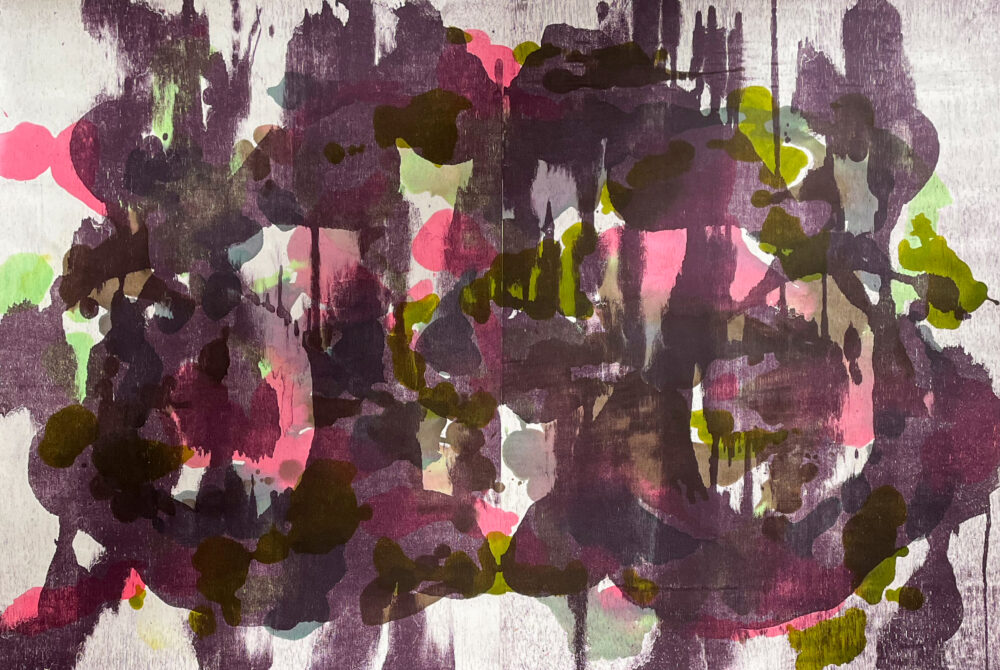
The following is an artist statment from my latest exhibition on at Red Gallery, Melbourne, 28 November – 10 December
What water leaves: the shape of things
I was drawn to mokulito to investigate a type of expressive mark-making that I could not as easily explore in my photo-based and digital printmaking. So, this work is, at a simple level, about gesture, juxtaposition and shape, but for me this also means it is inevitably about bodies, landscapes and the sometimes-uncanny resonance when all these elements sit together on a page.
My earlier exhibitions were concerned with either the recomposed body – playing on old master images – or the colour field of abstract photography. More recently my work has begun to explore what philosopher Timothy Morton calls ‘dark ecology,’ through the construction of abstracted digital landscapes. Each of these bodies of work in their own way was trying to find a way of negotiating the language of abstraction in a digital and post-digital era. There is a resonance of each of these ideas in this new work, a connection that has been made explicit in the pieces that combine digital prints and mokulito.
The French phenomenologist Maurice Merleau-Ponty suggests that painting is ‘autofigurative’ (1933/1993: 141) by which he seems to mean that even in the most realist traditions, the figure has a life of its own, it emerges from a confusion of line and tone and mark. Painting he says, “break[s] ‘the skin of things’ to show how the things become things and how world becomes world.”
As I explored the practice of mark-making, playing with the experimental and accidental happenstance of mokulito, I became increasingly interested in this process of breaking the skin of things, of what might emerge in the process of spilling ink onto board and layering it as printed marks on the page. The process itself is mesmerising because the marks emerge in different ways at different parts of the process, seeming to make real that ‘autofigurative’ emergence of the image. As the tusche – a special waxy lithographic ink – settles on the board and evaporates it ‘reticulates’ or forms patterns and as these patterns are inked and printed, they may emerge differently with each printing. The excitement and the challenge in this type of artmaking is to both surrender to, as well as harness, the accidental and emergent.
When shapes or marks emerge, we tend to want to define them through simile or metaphor: this is like that. Jane Bennett argues there is something deeper going on here than the merely associative, shape she suggests performs a direct kind of communication which links the human with the ‘vegetal’ essence of life. As she points out, Thoreau discovered this watching the ways water congeals with globules of thawing earth at the cusp of spring. He was suddenly struck by the ‘hieroglyphics’ of this sandy watery: for him suddenly everything, everybody was a congealed droplet…. There in the nose, that shape, a droplet, there in the tip of the finger, that shape again, a droplet, then in the shape of the eye, the nipple, the toe. The world, and all of us, a multitude of droplets.
Noticing these shapes that are us, that are everywhere and that dance and become something else, links us to the viscous materiality of things. As Thoreau says in another place: ‘there is nothing inorganic’.
Bennett suggests that this ‘mode of communication that proceeds via shape’ connects us to not only new ways of seeing but also new ways of being. Once attuned to these affiliative sensory connections “you become alert to them, and then there’s a slight but real kaleidoscopic shift in everything you see, hear, smell, touch, taste, and think. What becomes a little more sensible, conceivable, and plausible is the existence of a web of cross-body, shapely communications that subvents or is only vaguely hooked into more word-reliant networks. One may start to experience oneself less as an intersubjective being and more as an inter- and intra- twined shape.” (Bennett 2017: 103)
Bennett, J., 2017. ‘Vegetal life and onto-sympathy’ in Keller, C. and Rubenstein, M.J. eds., Entangled worlds: Religion, science, and new materialisms. Fordham Univ Press. pp.89-110.
Merleau-Ponty, M., 1933, ‘Eye and Mind in M Smith (ed), 1993, The Merleau-Ponty aesthetics reader: Philosophy and painting. Northwestern University Press.